Page 2751 of 4087
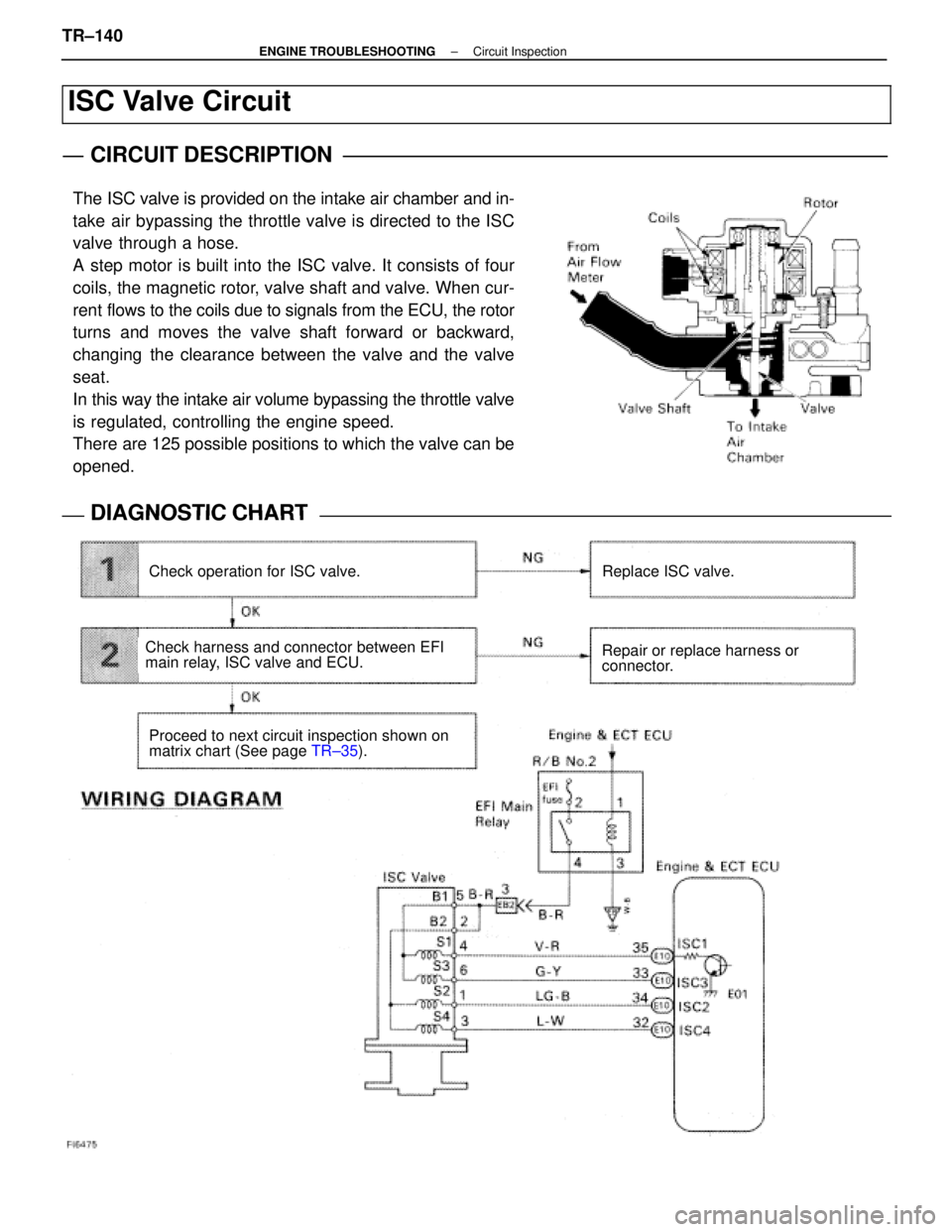
ISC Valve Circuit
CIRCUIT DESCRIPTION
The ISC valve is provided on the intake air chamber and in-
take air bypassing the throttle valve is directed to the ISC
valve through a hose.
A step motor is built into the ISC valve. It consists of four
coils, the magnetic rotor, valve shaft and valve. When cur-
rent flows to the coils due to signals from the ECU, the rotor
turns and moves the valve shaft forward or backward,
changing the clearance between the valve and the valve
seat.
In this way the intake air volume bypassing the throttle valve
is regulated, controlling the engine speed.
There are 125 possible positions to which the valve can be
opened.
DIAGNOSTIC CHARTDIAGNOSTIC CHART
Check operation for ISC valve.Replace ISC valve.
Repair or replace harness or
connector.
Proceed to next circuit inspection shown on
matrix chart (See page TR±35).
Check harness and connector between EFI
main relay, ISC valve and ECU.
TR±140±
ENGINE TROUBLESHOOTING Circuit Inspection
WhereEverybodyKnowsYourName
Page 2784 of 4087
INSTALLATION OF ALTERNATOR
(See Components on page CH±9)
1. INSTALL ALTERNATOR (a) Install the alternator and A/T oil cooler bracket with the
bolt and nut.
Torque: 37 N Vm (380 kgf Vcm, 27 ft Vlbf)
(b) Connect the alternator connector.
(c) Connect the alternator wire with the nut and cap.
2. INSTALL DRIVE BELT Install the drive belt by turning the drive belt tensioner coun-
terclockwise.
HINT: The pulley bolt for the belt tensioner has a left±hand
thread.
3. CONNECT CABLE TO NEGATIVE TERMINAL OF BATTERY
4. PERFORM ON±VEHICLE INSPECTION (See steps 6 to 8 on pages CH±6 to 8)
5. INSTALL ENGINE UNDER COVER
CH±20
±
CHARGING SYSTEM Alternator
WhereEverybodyKnowsYourName
Page 2790 of 4087
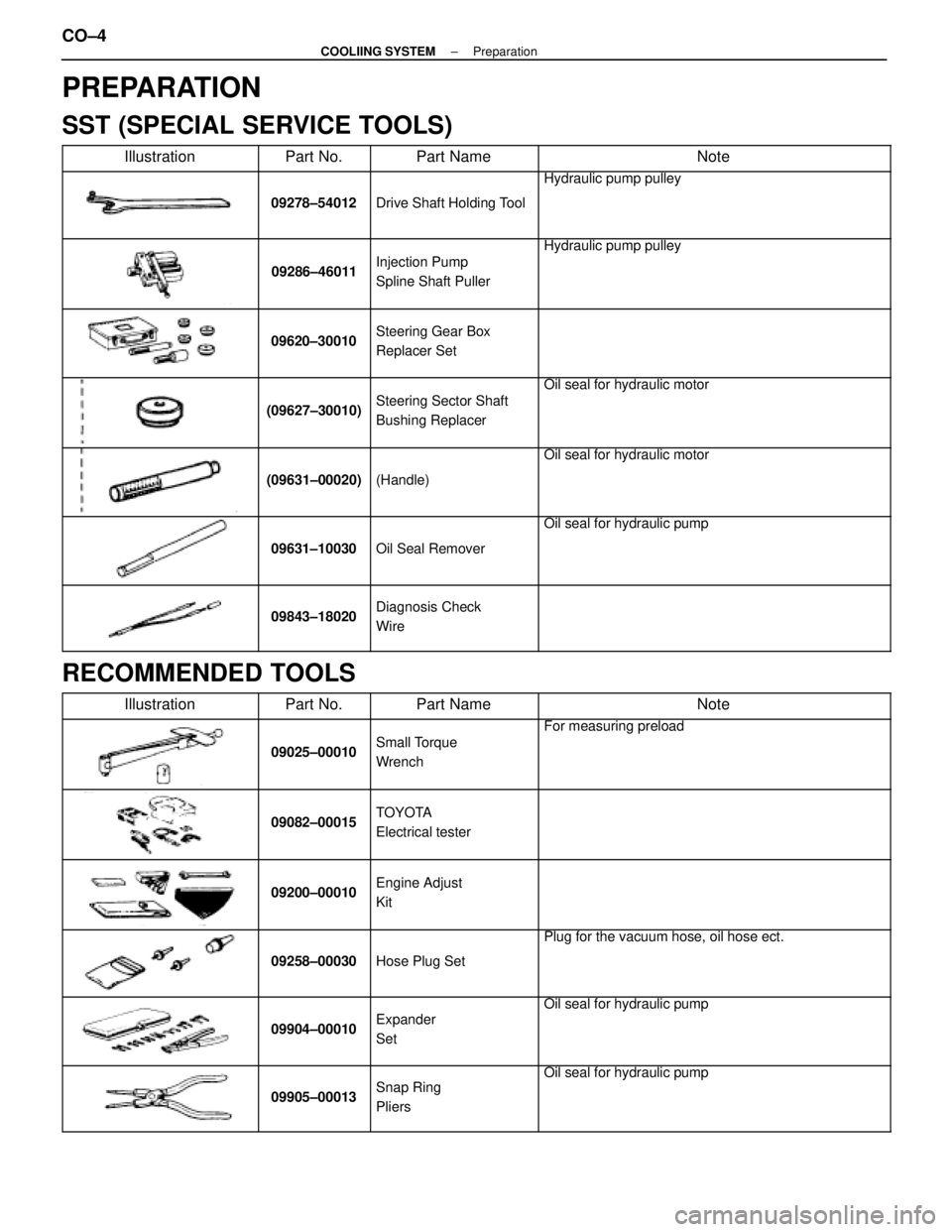
PREPARATION
SST (SPECIAL SERVICE TOOLS)
��������� ���������Illustration������ ������Part No.�������� ��������Part Name���������������� ����������������Note
��������� �
��������
���������
������ �
�����
������09278±54012
�������� �
�������
��������Drive Shaft Holding Tool
���������������� �
���������������
����������������
Hydraulic pump pulley
��������� �
��������
�
��������
���������
������ �
�����
�
�����
������09286±46011
�������� �
�������
�
�������
��������
Injection Pump
Spline Shaft Puller
���������������� �
���������������
�
���������������
����������������
Hydraulic pump pulley
��������� �
��������
�
��������
���������
������ �
�����
�
�����
������09620±30010
�������� �
�������
�
�������
��������
Steering Gear Box
Replacer Set
���������������� �
���������������
�
���������������
����������������
��������� �
��������
�
��������
���������
������ �
�����
�
�����
������(09627±30010)
�������� �
�������
�
�������
��������
Steering Sector Shaft
Bushing Replacer
���������������� �
���������������
�
���������������
����������������
Oil seal for hydraulic motor
��������� �
��������
�
��������
���������
������ �
�����
�
�����
������
(09631±00020)
�������� �
�������
�
�������
��������
(Handle)
���������������� �
���������������
�
���������������
����������������
Oil seal for hydraulic motor
��������� �
��������
�
��������
���������
������ �
�����
�
�����
������
09631±10030
�������� �
�������
�
�������
��������
Oil Seal Remover
���������������� �
���������������
�
���������������
����������������
Oil seal for hydraulic pump
��������� �
��������
�
��������
���������
������ �
�����
�
�����
������
09843±18020
�������� �
�������
�
�������
��������
Diagnosis Check
Wire���������������� �
���������������
�
���������������
����������������
RECOMMENDED TOOLS��������� �
��������
���������Illustration
������ �
�����
������Part No.
�������� �
�������
��������Part Name
���������������� �
���������������
����������������Note
��������� �
��������
�
��������
���������
������ �
�����
�
�����
������
09025±00010
�������� �
�������
�
�������
��������
Small Torque
Wrench���������������� �
���������������
�
���������������
����������������
For measuring preload
��������� �
��������
���������
������ �
�����
������09082±00015�������� �
�������
��������
TOYOTA
Electrical tester���������������� �
���������������
����������������
��������� �
��������
�
��������
���������
������ �
�����
�
�����
������09200±00010
�������� �
�������
�
�������
��������
Engine Adjust
Kit
���������������� �
���������������
�
���������������
����������������
��������� �
��������
�
��������
���������
������ �
�����
�
�����
������09258±00030
�������� �
�������
�
�������
��������Hose Plug Set
���������������� �
���������������
�
���������������
����������������
Plug for the vacuum hose, oil hose ect.
��������� �
��������
�
��������
���������
������ �
�����
�
�����
������
09904±00010
�������� �
�������
�
�������
��������
Expander
Set
���������������� �
���������������
�
���������������
����������������
Oil seal for hydraulic pump
��������� �
��������
�
��������
���������
������ �
�����
�
�����
������
09905±00013
�������� �
�������
�
�������
��������
Snap Ring
Pliers
���������������� �
���������������
�
���������������
����������������
Oil seal for hydraulic pump
CO±4±
COOLIING SYSTEM Preparation
WhereEverybodyKnowsYourName
Page 2792 of 4087
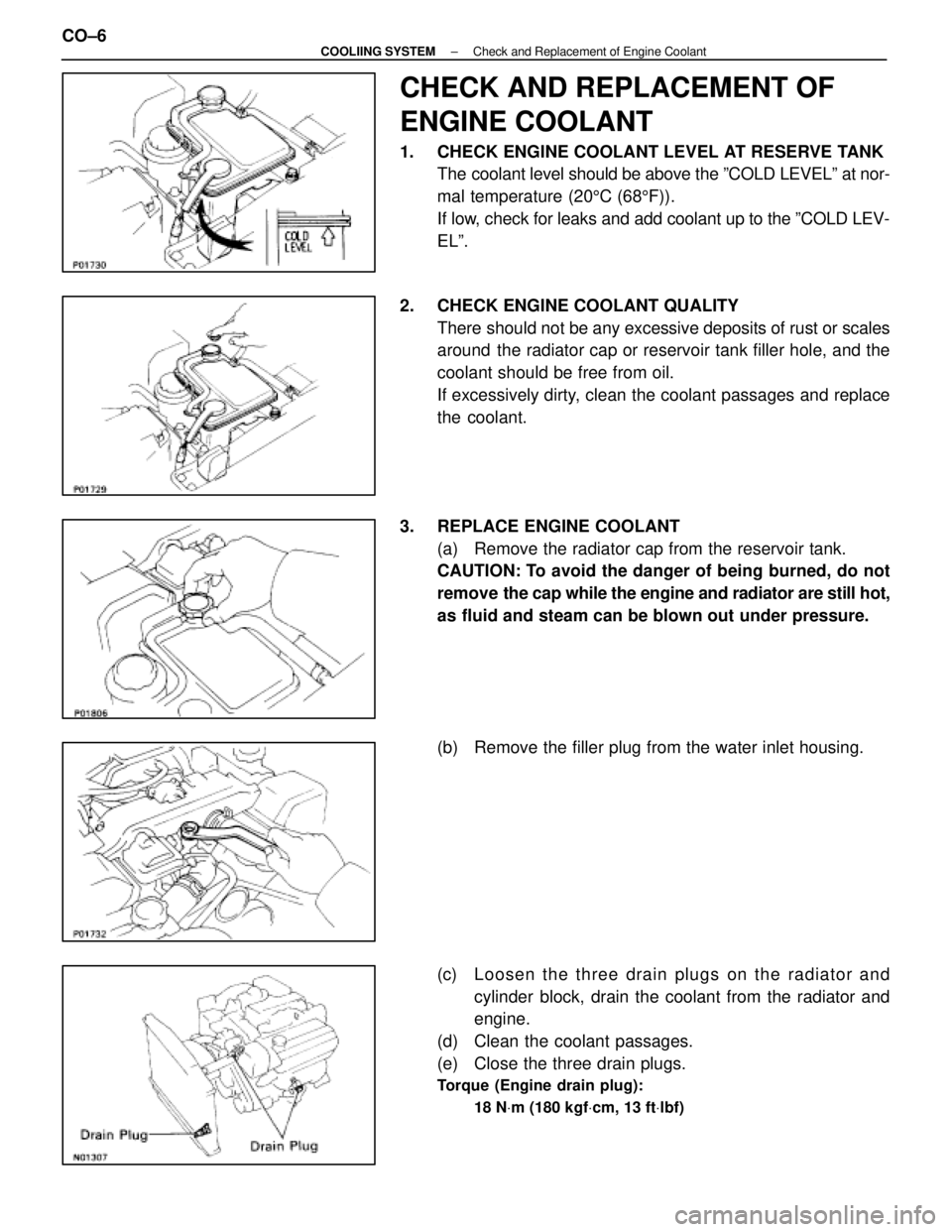
CHECK AND REPLACEMENT OF
ENGINE COOLANT
1. CHECK ENGINE COOLANT LEVEL AT RESERVE TANKThe coolant level should be above the ºCOLD LEVELº at nor-
mal temperature (20 5C (68 5F)).
If low, check for leaks and add coolant up to the ºCOLD LEV-
ELº.
2. CHECK ENGINE COOLANT QUALITY There should not be any excessive deposits of rust or scales
around the radiator cap or reservoir tank filler hole, and the
coolant should be free from oil.
If excessively dirty, clean the coolant passages and replace
the coolant.
3. REPLACE ENGINE COOLANT (a) Remove the radiator cap from the reservoir tank.
CAUTION: To avoid the danger of being burned, do not
remove the cap while the engine and radiator are still hot,
as fluid and steam can be blown out under pressure.
(b) Remove the filler plug from the water inlet housing.
(c) Loosen the three drain plugs on the radiator and
cylinder block, drain the coolant from the radiator and
engine.
(d) Clean the coolant passages.
(e) Close the three drain plugs.
Torque (Engine drain plug):
18 NVm (180 kgf Vcm, 13 ft Vlbf)
CO±6±
COOLIING SYSTEM Check and Replacement of Engine Coolant
WhereEverybodyKnowsYourName
Page 2802 of 4087
REMOVAL OF RADIATOR
(See Components on page CO±15)
1. REMOVE BATTERY CAUTION: Work must be started after approx. 20 seconds or
longer from the time the ignition switch is turned to the
ºLOCKº position and the negative (±) terminal cable is dis-
connected from the battery.
2. REMOVE ENGINE UNDER COVERS
3. DRAIN ENGINE COOLANT (See page CO±6)
4. REMOVE RADIATOR RESERVOIR TANK (a) Disconnect the coolant level sensor connector.
(b) Disconnect the following hoses:(1) Reservoir hose from water inlet housing
(2) Reservoir hose from radiator
(c) Remove the two bolts and reservoir tank bracket.
(d) Disconnect the reservoir tank from the reservoir tank bracket, and remove the reservoir tank.
5. DISCONNECT HOSES Disconnect the following hoses:(1) Upper radiator hose from radiator
(2) Lower radiator hose from radiator
(3) Two oil cooler hoses (for A/T) from radiator. Plug hose end.
CO±16
±
COOLIING SYSTEM Radiator
WhereEverybodyKnowsYourName
Page 2808 of 4087
ELECTRONICALLY CONTROLLED HYDRAULIC COOLING FAN
Description
In this way system, the cooling fan ECU controls the hydraulic pressure ac\
ting on the hydraulic motor, thus
controlling the speed of the cooling fan steplessly in response to the c\
ondition of the engine and air conditioner.
Operation
The hydraulic pump is driven by a drive belt (V±ribbed belt). The sole\
noid valve adjusts the volume of oil
sent from the hydraulic pump to the hydraulic motor which drives the fan dir\
ectly, thereby controlling the fan
speed. Oil which has passed through the hydraulic motor is cooled by the oil coole\
r before returning to the reservoir
tank. The solenoid valve is controlled by the computer in accordance with the E/G\
rpm, water temp. and A/C
signals. CO±22
±
COOLIING SYSTEM Electronically Controlled Hydraulic
Cooling Fan (Description, Operation)
WhereEverybodyKnowsYourName
Page 2810 of 4087
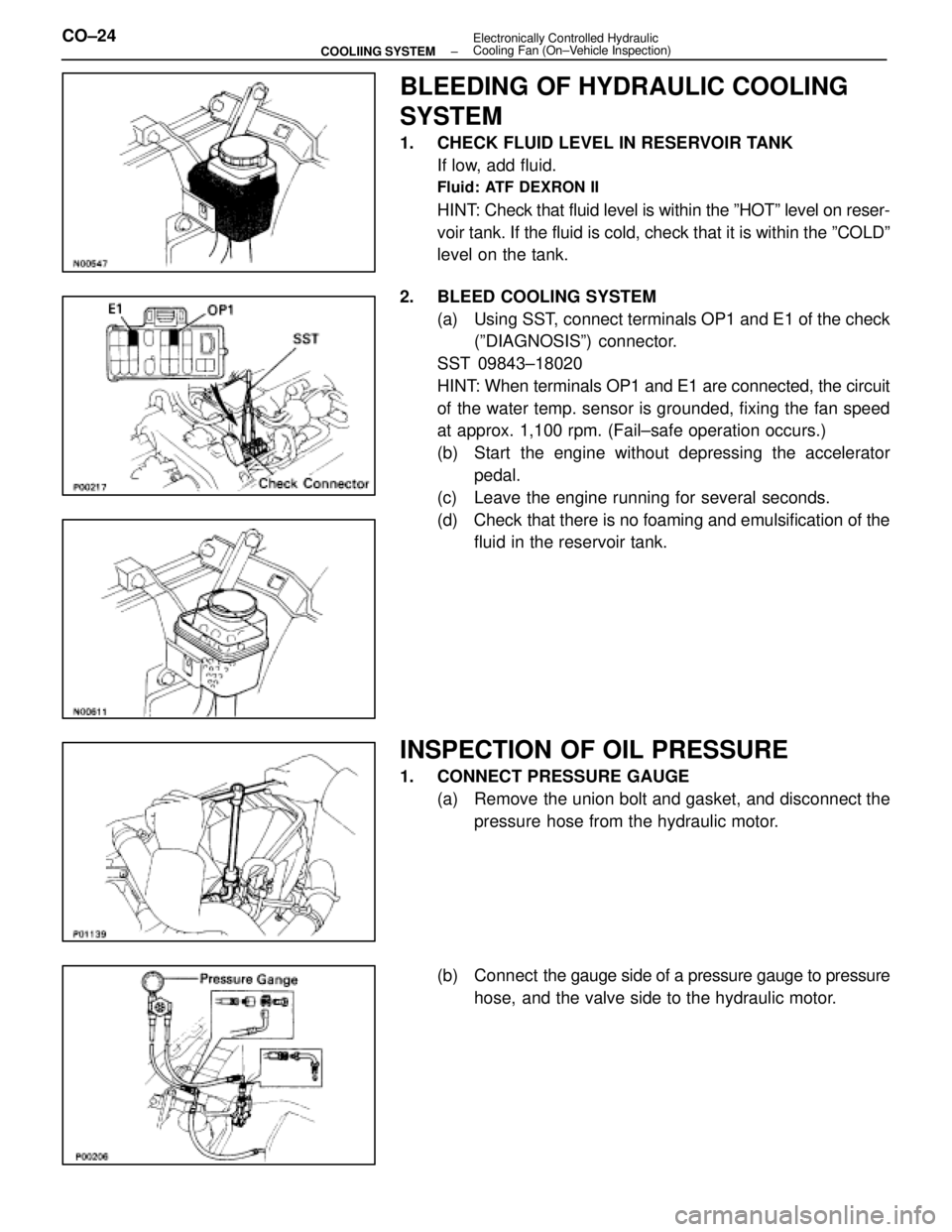
BLEEDING OF HYDRAULIC COOLING
SYSTEM
1. CHECK FLUID LEVEL IN RESERVOIR TANKIf low, add fluid.
Fluid: ATF DEXRON II
HINT: Check that fluid level is within the ºHOTº level on reser-
voir tank. If the fluid is cold, check that it is within the ºCOLDº\
level on the tank.
2. BLEED COOLING SYSTEM (a) Using SST, connect terminals OP1 and E1 of the check(ºDIAGNOSISº) connector.
SST 09843±18020
HINT: When terminals OP1 and E1 are connected, the circuit
of the water temp. sensor is grounded, fixing the fan speed
at approx. 1,100 rpm. (Fail±safe operation occurs.)
(b) Start the engine without depressing the accelerator pedal.
(c) Leave the engine running for several seconds.
(d) Check that there is no foaming and emulsification of the fluid in the reservoir tank.
INSPECTION OF OIL PRESSURE
1. CONNECT PRESSURE GAUGE
(a) Remove the union bolt and gasket, and disconnect thepressure hose from the hydraulic motor.
(b) Connect the gauge side of a pressure gauge to pressure
hose, and the valve side to the hydraulic motor.
CO±24
±
COOLIING SYSTEM Electronically Controlled Hydraulic
Cooling Fan (On±Vehicle Inspection)
WhereEverybodyKnowsYourName
Page 2811 of 4087
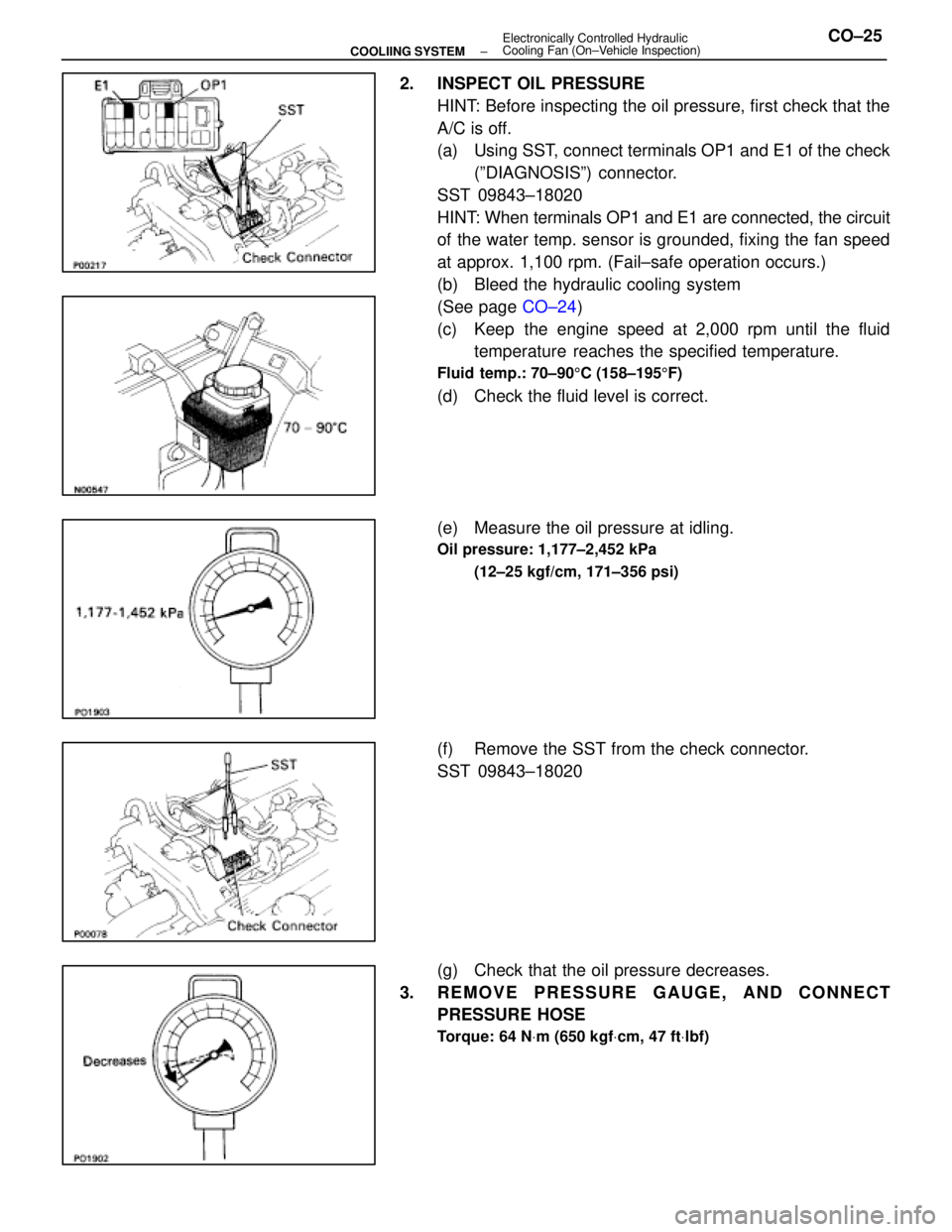
2. INSPECT OIL PRESSUREHINT: Before inspecting the oil pressure, first check that the
A/C is off.
(a) Using SST, connect terminals OP1 and E1 of the check(ºDIAGNOSISº) connector.
SST 09843±18020
HINT: When terminals OP1 and E1 are connected, the circuit
of the water temp. sensor is grounded, fixing the fan speed
at approx. 1,100 rpm. (Fail±safe operation occurs.)
(b) Bleed the hydraulic cooling system
(See page CO±24)
(c) Keep the engine speed at 2,000 rpm until the fluid temperature reaches the specified temperature.
Fluid temp.: 70±90 5C (158±195 5F)
(d) Check the fluid level is correct.
(e) Measure the oil pressure at idling.
Oil pressure: 1,177±2,452 kPa
(12±25 kgf/cm, 171±356 psi)
(f) Remove the SST from the check connector.
SST 09843±18020
(g) Check that the oil pressure decreases.
3. REMOVE PRESSURE GAUGE, AND CONNECT PRESSURE HOSE
Torque: 64 N Vm (650 kgf Vcm, 47 ft Vlbf)
±
COOLIING SYSTEM Electronically Controlled Hydraulic
Cooling Fan (On±Vehicle Inspection)CO±25
WhereEverybodyKnowsYourName